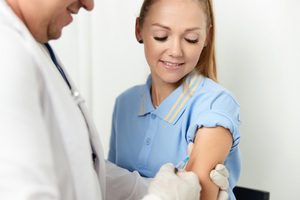Dermal Fillers
Use Solv to find a skin specialist in your area that offers dermal fillers. Solv features a directory of only the highest-rated skin care doctors in your area so that you can find the best dermal filler provider. Solv will even let you book a same-day dermal fillers appointment directly from its website.
All about dermal fillers
Dermal fillers are a cosmetic treatment that can help reduce the appearance of fine lines and wrinkles by plumping up the skin. These injectable treatments are minimally invasive and can be administered by a licensed skin care doctor or dermatologist.
Dermal fillers contain ingredients like hyaluronic acid (HA) that can contribute to a younger-looking appearance. According to the FDA, dermal fillers are most commonly used by people who want to improve the appearance of facial lines and restore volume that has been lost due to aging or certain medical conditions.
How do dermal fillers help reduce the appearance of aging?
Dermal fillers can reduce signs of aging by plumping up areas of the face to help soften and reduce fine lines and wrinkles. According to the University of Utah, some dermal fillers can stimulate skin cells to produce a higher amount of collagen, which helps you achieve a fuller, more youthful-looking appearance. The university adds that many dermal fillers also contain HA, a naturally occurring substance that keeps the skin hydrated and lends to an overall rejuvenated look.
What dermal fillers do
Dermal fillers can reduce fine lines and wrinkles on the face and restore volume to areas that may look hollow or sagging. According to the University of Utah, dermal fillers can also plump the face to reduce scarring, such as that caused by acne. Facial thinning caused by sun damage, surgery, weight loss, or trauma may be improved with dermal fillers, adds the university.
What are dermal fillers?
Dermal fillers are injectable treatments that can soften creases, fill in crevices, and add volume to shallow areas of the face, says Ohio State University (OSU). They can also add volume to thin lips and reduce scarring caused by acne, nicks, and scrapes. The FDA says dermal fillers contain gel-like substances that are generally meant to create a smoother or fuller appearance.
Why are there so many different types of fillers?
Different fillers have different uses that can address specific parts of the face. For instance, lip fillers can plump thin lips, while cheek fillers can add volume to cheeks that may be hollow or sagging. In addition, smile line fillers may soften and fill in creases and wrinkles around the mouth caused by smiling or smoking.
Most popular dermal fillers
Your dermatologist can often help you choose the right dermal filler based on the appearance of your skin and on what you hope to accomplish with treatment. Some of the most popular dermal fillers contain HA, calcium hydroxylapatite, polylactic acid, and polymethylmethacrylate beads (PMMA), according to the University of Utah
Hyaluronic acid (HA)
HA fillers are the most commonly used fillers in the U.S., reports the University of Utah. These natural compounds bind to water, making them effective at restoring volume in the skin and softening fine lines and wrinkles. OSU adds that HA fillers can also reduce skin depressions caused by scars and injuries and treat vertical “smoker’s lines” around the lips.
Calcium hydroxylapatite
This ingredient is a mineral-like compound that is found naturally in bone tissue, says OSU. It adds that complications from dermal fillers containing calcium hydroxylapatite are rare, given how these fillers are biosynthetically produced without animals or animal products. Dermal fillers that contain this compound can help minimize moderate to deep creases and add fullness to cheeks and facial contours.
Polylactic acid
Dermal fillers with polylactic acid usually plump the lips and fill in laugh lines and deep folds around the nose and mouth. Polylactic acid also stimulates your body’s natural collagen production, reports OSU. Compared with other dermal fillers, fillers with polylactic acid produce results that appear gradually over time. OSU says it can take four to six weeks to see the full effect of these fillers.
Polymethylmethacrylate beads (PMMA)
PMMA fillers are often regarded as an alternative to collagen replacement therapy or hyaluronic therapy, reports OSU. These dermal fillers are effective at treating medium to deep wrinkles and folds in the face—particularly those that extend from the nose to the mouth. OSU says full results from PMMA fillers are usually visible after about three months.
Find Dermal Fillers near you
- Alabama
- Alaska
- Arizona
- Arkansas
- California
- Colorado
- Connecticut
- Delaware
- Florida
- Georgia
- Hawaii
- Idaho
- Illinois
- Indiana
- Iowa
- Kansas
- Kentucky
- Louisiana
- Maine
- Maryland
- Massachusetts
- Michigan
- Minnesota
- Mississippi
- Missouri
- Montana
- Nebraska
- Nevada
- New Hampshire
- New Jersey
- New Mexico
- New York
- North Carolina
- North Dakota
- Ohio
- Oklahoma
- Oregon
- Pennsylvania
- Rhode Island
- South Carolina
- South Dakota
- Tennessee
- Texas
- Utah
- Vermont
- Virginia
- Washington
- Washington DC
- West Virginia
- Wisconsin
- Wyoming
Dermal Fillers FAQs
How long do dermal fillers last?
The results of dermal fillers can last for several months, depending on the type of filler you receive and how well you take care of your skin. According to Harvard Medical School, the results of HA fillers typically last at least six months before the ingredients are gradually absorbed by your body. Your dermatologist can give you a more accurate time frame regarding how long your results will last from dermal fillers.
Are dermal fillers safe?
Dermal fillers are medical devices regulated by the FDA, reports the federal agency. It adds that despite being FDA-regulated, dermal fillers come with risks like any other medical procedure. Common risks of dermal fillers, according to the FDA, include bruising, redness, swelling, pain, tenderness, itching, rash, and difficulty performing certain activities (when injected into the hands).
What is the difference between Botox and fillers?
The active ingredient in Botox is botulinum toxin, which prevents muscles from tightening to reduce the appearance of wrinkles, reports the FDA. Dermal fillers are different in that they contain ingredients that add volume to the face to soften fine lines and wrinkles and make them less noticeable. The FDA adds that Botox is mainly used to temporarily improve frown lines, forehead lines, and crow’s feet.
How much do fillers cost?
The cost of dermal filler treatment depends on factors such as rates set by the dermatologist or skin specialist, the type of filler you choose, and the number of treatment sessions. Cosmetic procedures like dermal fillers are not covered by health insurance, says the University of South Florida. Ask your dermatologist for more information about the cost of dermal fillers.
What’s it like getting dermal fillers?
Dermal fillers are injected into your skin using a tiny needle. According to OSU, appointments typically range between 15 minutes and one hour. Before your injection, your dermatologist will apply a topical anesthetic or administer a local anesthetic to reduce any pain or discomfort you may feel during the procedure. Your skincare doctor can tell you more about what to expect during your treatment.
What is the dermal filler recovery process like?
You may experience some redness, tenderness, swelling, and/or bruising in the treated areas, which typically resolve within one or two days, reports OSU. It adds that you may also experience temporary effects of numbness or lumpy areas. Your dermatologist may recommend avoiding intense physical activity for a few days, though you can resume all other activities immediately following your appointment.
What if I don’t like the result? Can fillers be removed?
Dermal fillers produce temporary results that can last up to several months, after which they gradually go away. However, according to a study published in the Dermatology Online Journal, the results of HA fillers may be reversed by injecting a substance called hyaluronidase into treated areas. Your dermatologist can discuss your available options for the removal of dermal fillers if you are unsatisfied with the results of your procedure.
Are dermal fillers right for me?
Dermal fillers may be right for you if you want to reduce the appearance of fine lines and wrinkles or add volume to areas of the face that may look hollow or sagging, notes the Dermatology Online Journal. Dermal fillers can also help reduce the appearance of scarring and plump up thin lips. If you’re not completely sure whether dermal fillers are right for you, ask your dermatologist to perform an evaluation and recommend the best cosmetic treatment.
Where can I get dermal filler treatment near me?
Type “dermatologist near me” into your search engine to find nearby face filler treatment. Better yet, use the directory at Solv to identify only the highest-rated dermal filler providers in your area. Solv makes it convenient for you to find a dermatologist and book a same-day or next-day appointment directly from its website.
Solv has strict sourcing guidelines and relies on peer-reviewed studies, academic research institutions, and medical associations. We avoid using tertiary references.
Everyday Healthcare, Simplified
Expert advice to help you live your best life








